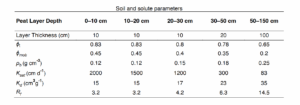Exercise 2 – Calculating Water and Solute Flux from a Peat Deposit with Weak Depth Dependent Hydraulic Conductivity
The movement of contaminants is highly dependent on the hydrophysical processes operating within a peatland. Here we consider a peatland with a constant contaminant source some distance upgradient from an adjacent stream. The contaminant is weakly adsorbing and has reached geochemical equilibrium in the peatland.
The absorption of the contaminant can be represented by a linear adsorption isotherm with no limitation on adsorption sites, thus a retardation coefficient (Rf) can be determined as follows.


To simplify the evaluation, we assume the contaminant has come to equilibrium with the peat and that the amount of contaminant in the mobile water fraction (Cf) is proportional to the inverse of the retardation factor.
Under the high water table regime, the water table is at the peatland surface and the horizontal hydraulic gradient in all layers is (i) is 0.004. Under the low water table regime, the water table is 20 cm below the peat surface and the horizontal hydraulic gradient for all layers is 0.001. The relevant hydraulic and transport parameters are provided in the following table.

Determine the proportion of contaminated water that will be exported to the adjacent stream under high and low water table regimes in several distinct peat layers.
Assume:
- The flow within the peatland is parallel to the water table and that the bottom of the peatland is no-flow boundary.
- The water table remains constant.
- The width (w) of the flow face between the peatland and stream is 20 m.
- The flow conforms to Darcy’s Law.
- There is a constant amount of contaminant at the interface but the concentration of contaminant in the pore water is 1 for a layer with a retardation factor of 1, while the concentration in the pore water is 1/Rf) for layers with Rf > 1.
Contrast the two water table regimes and calculate the difference in proportion of contaminated water between the two scenarios. What proportion of the contaminant moves through the upper peat layer? How does this compare to the water flow?
